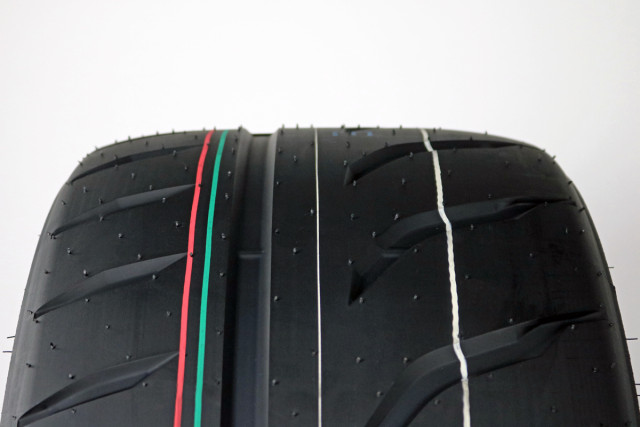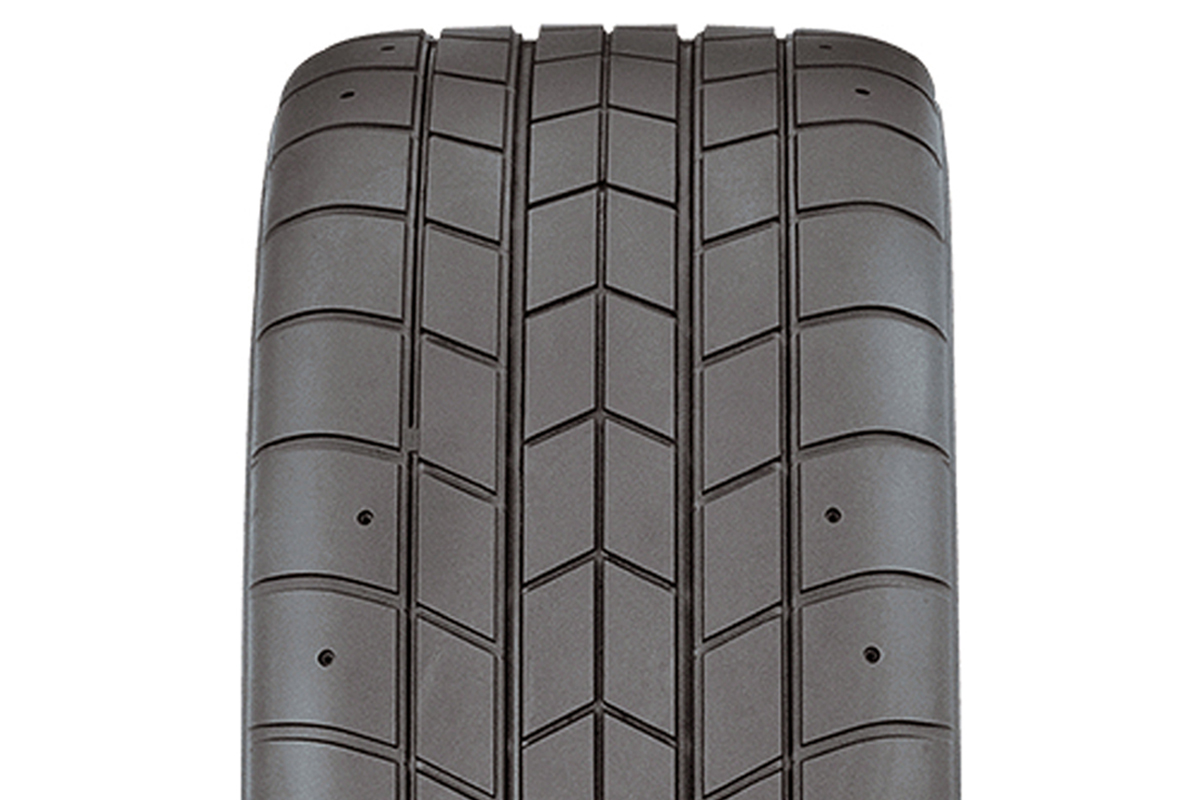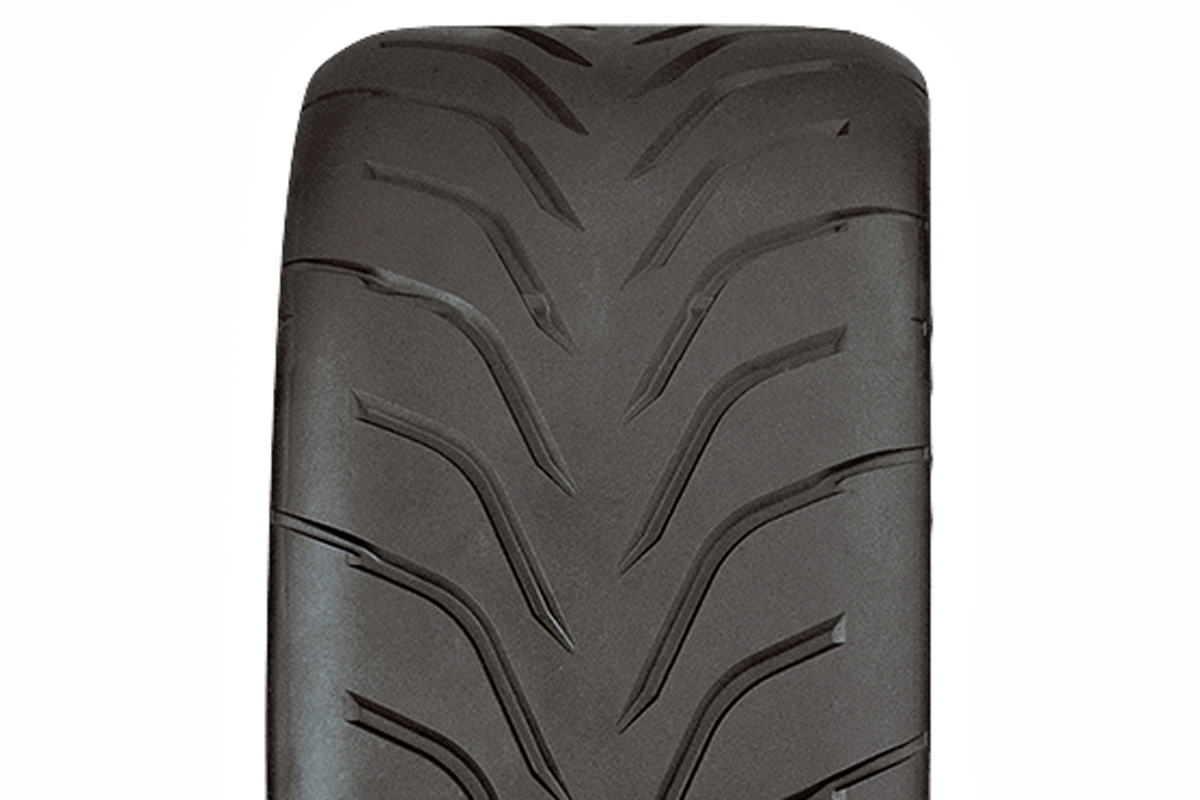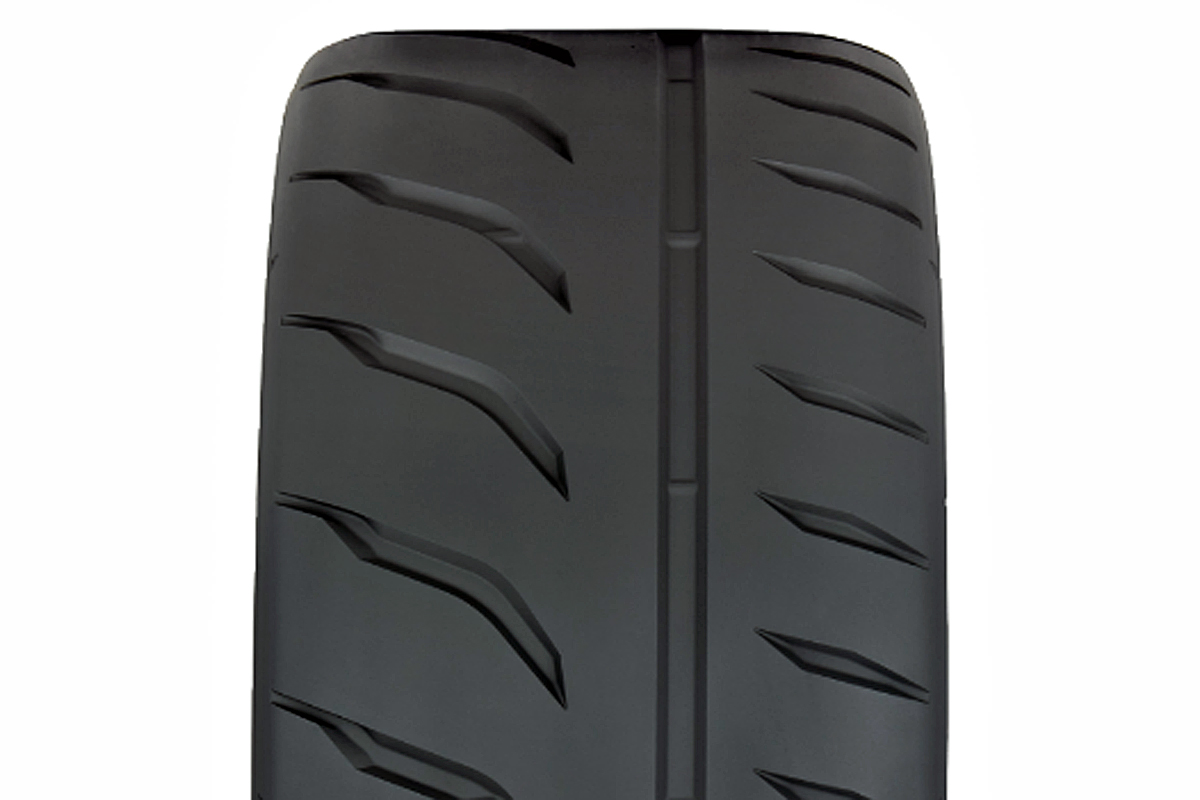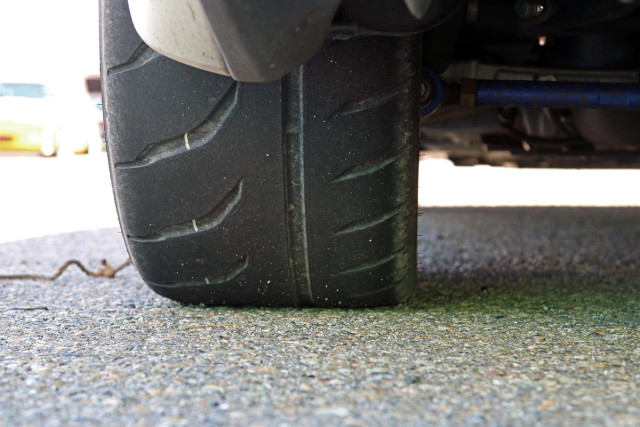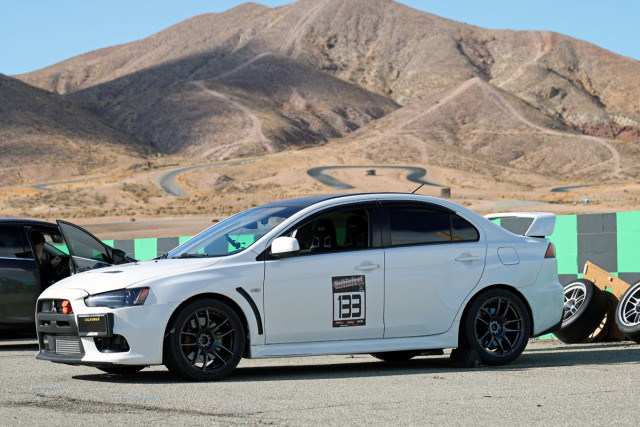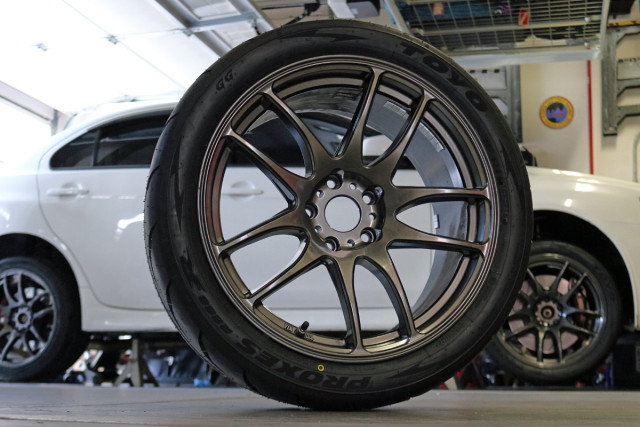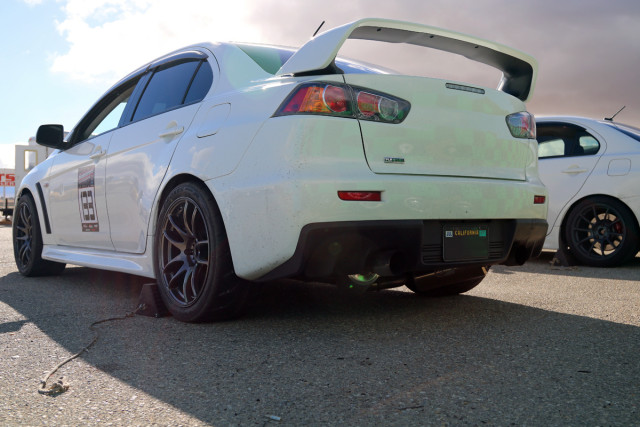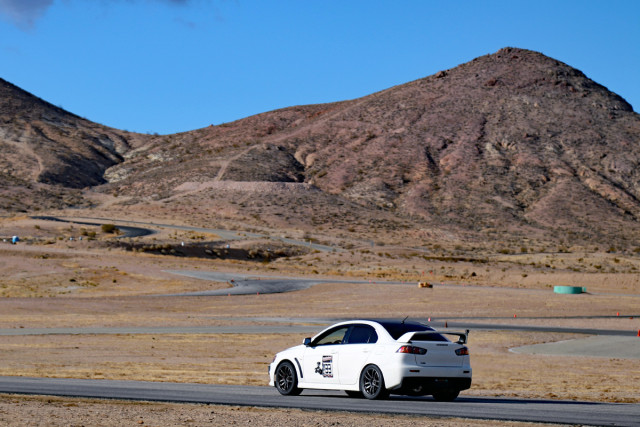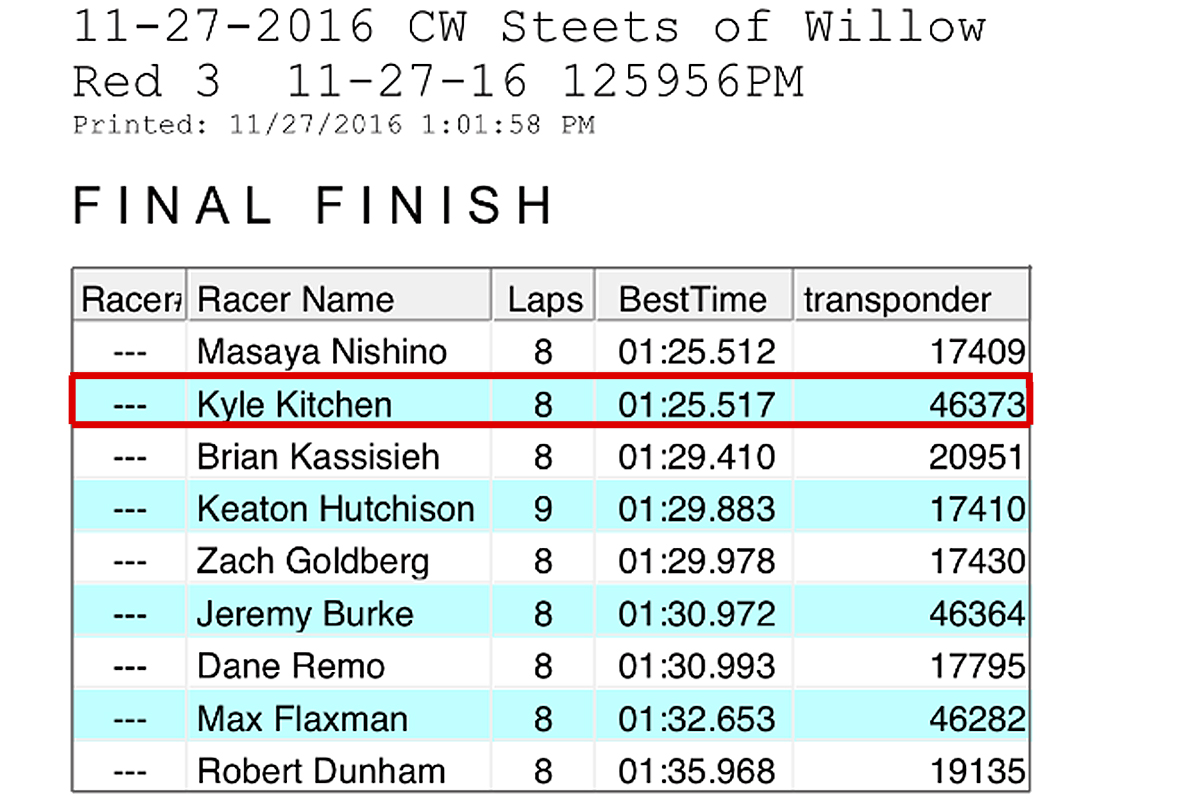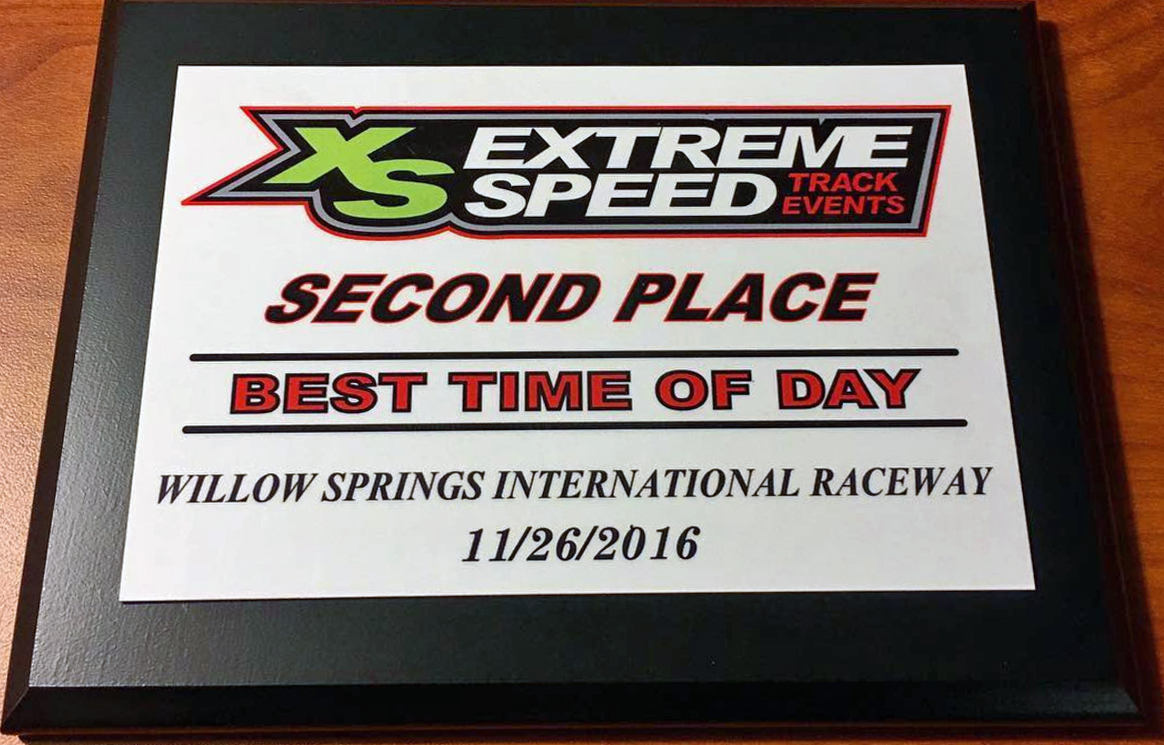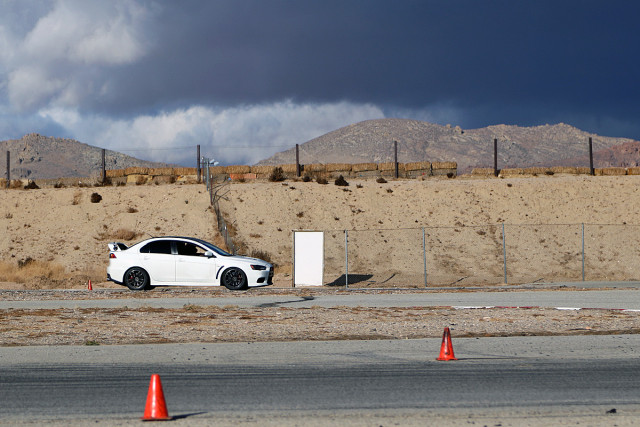From NASA and SCCA sanctioned wheel-to-wheel racing to hill climbs, Gymkhana, and even time attack and educational HPDEs (high performance driver education); serious road racing enthusiasts are very similar to professional race teams in that they are very meticulous about their choice of rubber. The driver needs to have total confidence that whatever tire they put between their wheels and the tarmac will be able to handle the abuse seen over multiple hot laps without giving up grip, structural integrity or predictability in performance; otherwise known as precious seconds.
Toyo Tires has been the competition racing tire choice for many championship winning professionals and serious amateur racers for decades. We were recently sent a set of Toyo’s newly released racing compound (R-comp) tires, the Proxes R888R, so we did what any track junkie would do — threw them on our Evo X time attack project car and headed out to our home test track Willow Springs International Raceway in Rosamond, California, for some clockwise torture testing on the 1.55-mile road course, Streets of Willow.
It’s Official North America, Say Hello To The Toyo Proxes R888R
R888R Manufacturer Specifications And Recommendations
- Treadwear Grade: 100
- Traction Grade: AA
- Temperature Grade: A
- Wheel Diameter: 13-inches up to 20-inches
- Tire Width: 185 mm to 345 mm
- Sidewall Profile: 30 up to 60-series
- Optimal Tread Temperature: 160 degrees F to 220 degrees F
- Hot Inflation Pressure Range: 32 psi to 38 psi
- Camber: -1 degrees to -3 degrees
- Caster: “As much positive as possible”
“The Proxes R888R is an evolution of the race-winning Proxes R888, delivering even faster lap times and better dry handling,” says Toyo Tire’s website. “The credit goes to a new tread design and an improved contact patch that puts more rubber on the track. Racers will also appreciate the predictable handling and how quickly the Proxes R888R reaches optimal operating temperature.”Just as the R888 was introduced as an improvement to the infamous Proxes RA1, the R888R further builds on this foundation, combing through data and driving impressions from professional racers from multiple racing series across the globe in an effort to continuously improve their products and shave seconds off of lap times.
The R888R will improve traction with any vehicle but will remain more consistent when used on a vehicle heavy enough to keep the tread within the optimal temperature range like our Evo, but not too heavy as to overheat the tire. Toyo also recommends this tire for vehicles such as the BMW 3-series, BMW 4-series, Porsche 911, Porsche Cayman, Chevrolet Corvette and other welterweight vehicles of any drivetrain configuration.
R888R Versus R888
We have all seen the marketing gimmicks employed by companies in just about every industry introducing a new product that is nothing more than the previous model with a different cover. The 100 treadwear R888R is far from this category. Toyo’s team of engineers worked tirelessly to find any areas of improvement, where even a fraction of a second could be shaved off of a lap time. The R888R’s new tread pattern creates a contact patch that gives the tire a noticeable bump in dry traction for improved braking distance and stability, acceleration, and cornering speed versus its older sibling.
“The Proxes R888R starts with the same advanced ‘GG‘ R-compound as the R888, providing the familiar quick warm up characteristics and progressive breakaway predictability that racers have come to love,” says Jay Jones of Toyo. “The major improvements come from the more advanced casing design that utilizes a Rayon ‘Super-High’ turn up carcass with steel side plies, producing an aggressive asymmetric tread pattern with a strong sidewall, a wide center rib for increased steering response, and a large outer shoulder contact patches to further improve mid-corner lateral grip for faster lap times, improved consistency and more driver confidence.”
Comparing To Previous Generations
Prior to acquiring the new R888R shoes, our Evo X was running a well used set of the classic 100 treadwear Proxes RA1 competition tires. Since its introduction in 1991, the RA1 has carried a loyal following and has continued to prove itself as a solid R-comp option for amateur racers even today.
When comparing the tread pattern of the RA1 to the R888R, it’s immediately obvious that some dry traction sacrifices were made on the RA1 in exchange for improved wet grip (at full tread depth anyway).
The smaller contact patches and more intricate water channels are able to evacuate more water efficiently, but also reduces the tire’s contact surface area, reducing overall dry grip and increasing the possibility of tread block squirm. The R888Rs wide outer tread blocks greatly improve lateral grip over the RA1 and R888, and the water evacuation channels provide similar wet traction performance as the R888, but can’t quite grab a wet surface as well as the RA1.
The evolution of the three 100 treadwear Toyo Proxes DOT-approved competition tires: the classic RA1 (left), R888 (center) and the new R888R (right).
Hitting The Sweet Spot
Like any performance tire, the Toyo Proxes R888R has ideal operating ranges for its various inputs to be able to achieve its ultimate performance such as tire temperature, hot tire pressure, and even camber and caster settings. Unlike racing compound tires that reach optimal performance after heating up and softening the tread, your average set of street tires are made from a much harder compound (to improve tread life) and will not display a noticeable improvement.
The R888R has an optimal operating temperature between 160 degrees F and 220 degrees F. If you find yourself below the cooler end of this range, the tires will be noticeably less sticky and the compound itself will be too firm. If you push the tires over the 220 degree F mark you will notice a reduction in grip and predictability as the compound becomes too soft and begins to get greasy. If you spend too much time in this area the tarmac will begin chewing up large chunks of tread, greatly reducing the life and performance of the tire.
The optimal hot inflation pressure for the R888R is identical to the R888 and is found closer to what would be expected of most street tires. Toyo’s engineers designed this tire to operate at its best when hot pressure is set between 32 psi and 38 psi, where it will provide the highest grip, display crisp and direct steering response, and prevent unusual tire wear.
The majority of track-prepped cars take into account the specific needs of the tire when setting up suspension geometry, most important are camber and caster settings. Negative camber improves lateral grip by moving the point where the rubber meets the road further towards the inside shoulder of the tire, increasing the outside shoulders contact with the road when exposed to high lateral loads and preventing sidewall rollover.
Toyo’s team found that the best suspension settings for the R888R are found with 1 to 3 degrees of negative camber and “as much positive caster as possible.” These requirements make it blatantly obvious that the R888Rs were really designed for the road course and will wear very quickly if used on the street with these settings.
Our time attack Evolution X GSR project is in a bit of a transition at the moment. That is, transitioning from a daily driver and weekend warrior to a dedicated track car. The car is currently stripped from the rear seats back through the trunk, in preparation for a roll cage, and features a fully built Garrett GTX3076R equipped 4B11T engine pushing out 538 horsepower and 446 lb-ft of torque at the wheels.
The car is using Girodisc two-piece slotted brake rotors and Raybestos ST43 brake pads with stainless steel braided brake lines. As far as suspension goes, at this point our Evo is still using the factory equipped KYB shocks with over 60,000 miles on them and a set of second-hand Swift Sport lowering springs with just as many, if not more miles; and absolutely no aero beyond what is offered from the factory. The only suspension modifications beyond the Swift springs being a Hotchkis 32 mm rear sway bar, Hotchkis rear endlinks, and Megan Racing rear camber arms.
So, with the 275/35ZR18 R888Rs mounted to a set of 9.5-inch wide wheels, we headed out to Streets for some testing with me behind the wheel.
When we arrived at the track just before 7 a.m. we were greeted with an air temperature barely reaching 39 degrees F, with moderate rain and a strong wind chill pushing temperatures down to just above freezing. Definitely less than ideal conditions for a track event.
Due to the severe weather and a lack of waterproof housings, we were unable to pull out our photography equipment and GoPros until later in the morning when the rain subsided. But that didn’t stop us from adventuring out onto the track for an early morning wet session.
When our first session started at 9:00 a.m., air temperature was still a fairly cold 44 degrees F and the rain was still heavy enough to create standing puddles and runoff streams at various locations around the track. We knew our starting tire pressure would be too low, so we raised our cold pressure from 26 psi to 32 psi with a hot target pressure of 36 psi. Raising the tire pressure for very wet conditions will help to prevent hydroplaning by decreasing tire deflection, rounding out the shape of the tire to create a narrower contact patch, and pulling open the water channels in the tread for improved water evacuation.
While there was a significant reduction in traction when the track was wet, we were pleasantly surprised with how predictable the wet breakaway characteristics of the R888Rs were in combination with the Evo’s all-wheel drive. Keeping as much of the Evo’s momentum moving forward as possible was an intricate dance between throttle position and steering input, but the R888Rs still provided enough confidence inspiring lateral control for a best wet lap time of 1:34.7.
Based on the tire’s wet performance, it seemed we hit the sweet spot for wet pressure for our setup right out of the gate. When checking tire pressure and tread temperature upon re-entering the paddock we recorded tire pressure between 36 psi and 37 psi – right on target – and tread temperature was fairly even – averaging between 124 and 132 degrees F across the contact area. This was definitely on the cool side but expected with the cool down time while pulling into the paddock plus the cold and wet track surface.
The rain finally stopped around 10:30 a.m., giving way to an eventual 52 degree F high by the afternoon, but the strong winds persisted and the skies stayed mostly cloudy, so the track’s surface temperature only varied by roughly 30 degrees F throughout the day. With the track drying out and breaks in the clouds allowing the sun to intermittently warm up the tarmac, we immediately focused on readjusting tire pressure. With almost two hours since our last session, the tires settled back to their cold pressure, which we then lowered to 27 psi with a hot target of 32 psi.
By the third session of the day we had pressure dialed in to 34 psi hot, tire temps were between 182 and 194 degrees F, the track had fully dried, and the air temperature finally broke 50 degrees F; and that’s when these R-comps really started to shine. On a dry track with a 60 degree F asphalt temperature, we could feel the R888Rs getting progressively stickier with each corner of the warm up lap. After passing through the chicane and coming into Turn 10 of the first cold lap, the GG compound of the Proxes let us know it was already up to temperature by producing stomach churning grip as we trail braked and rotated into the 90 degree corner.
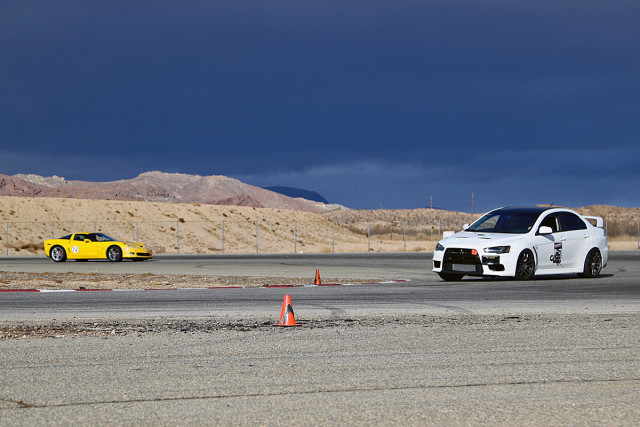
Notice the excessive body roll produced by the mismatched combination of suspension components and power delivery. The R888Rs handled the awkward weight transfer and unbalanced load produced while pushing the Evo through turn after turn without even batting an eye.
Like any tire, push them too hard and they will let you know by producing an audible screech. But keeping the vehicle in control required fewer mental resources than other tires we have used on the Evo previously. The R888R provided very predictable and progressive breakaway characteristics when pushed to the limit, and the sidewall is stiff enough to not roll over or noticeably flex even underneath the 3,400+ pound Evo.
Hot lap after hot lap I was blown away by the R888Rs performance. The combination of high horsepower, the Evo’s love for oversteer, and the factory shocks/struts really put these tires through the ringer. But they produced amazing grip throughout the entire day, handling the Evo’s excessive body roll with ease and producing lateral G-forces as high as 1.538, measured using our Vbox Performance Box on our fastest lap.

A map of Streets of Willow displaying the max lateral G-forces and speed of our Evo X on our fastest lap at various points of interest. The highest G’s were experienced in turn 8, “the bowl,” and peaked at 1.538.
Final Thoughts
With nearly 40 other drivers participating in the track event hosted by Extreme Speed Track Events, our best lap time of 1:25.517 was fast enough to make us the second fastest time of the day and the recipient of an awesome plaque. Our time was bested by an older gentleman behind the wheel of a fully track prepped Evo VIII. His best lap you ask? 1:25.512…
After putting the Toyo’s through their paces with a full day of mixed wet, cold and dry racing, it’s safe to say that this will continue to be the tire of choice for our time attack project Evo. Dry grip and breakaway predictability has been improved leaps and bounds over the RA1 we used previously. Higher entry and exit speeds were hit with more comfort, and lateral grip was confidence inspiring. Keeping the momentum of the heavier Evo moving in the direction we wanted required less corrections and fewer mental resources, allowing me to focus more on other tasks such as driving line, braking, and my surroundings.
It’s definitely not a racing slick, but the latest evolution of the Proxes competition tire is impressive to say the least. It’s the perfect tire for someone looking for the best balance between “streetability” and bead punishing grip. Be sure to check back often to continue following our quest for all out power and grip in our Evo X. We can’t wait to head back out to Streets in the near future to see what kind of lap times and telemetry data we achieve with the R888R’s once a proper set of coilovers and a roll cage are installed in our project Evo. Then we can start participating in sanctioned time attack events.
https://





